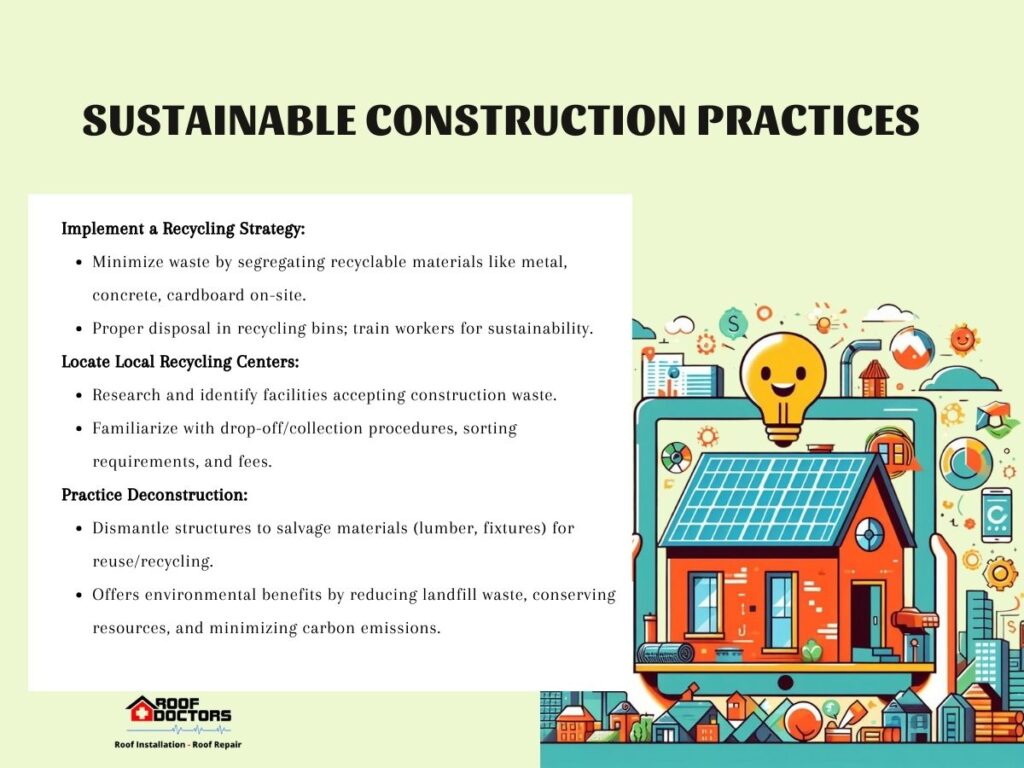Are you looking for ways to cut down on roofing waste during home renovations ? In the dynamic world of construction, effective waste reduction doesn’t start at the site; it begins with meticulous planning and estimation. Before the first brick is laid or the initial nail is hammered, a comprehensive understanding of potential waste materials is paramount.
By estimating the volume and weight of these materials, implementing safety measures like fall protection, and choosing the appropriate dumpster size, construction projects can minimize waste and optimize resource allocation. Let’s delve into these strategies in detail:
Estimating Waste Volume and Weight
Estimating waste volume and weight is important for effective waste management in construction projects. By accurately assessing materials like shingles, moss growth, water-soaked wood, corrosion, and debris accumulation, contractors can minimize excess waste and ensure efficient project outcomes.
- Shingles: Shingles are a common roofing material, and estimating their volume is crucial for waste management. Calculate the square footage of the roof area to determine the quantity of shingles needed. This estimation ensures you order just enough materials, minimizing excess waste.
- Moss or Ivy Growth: Exterior surfaces covered in moss or ivy can pose challenges during construction. Assess the extent of growth and plan for removal or treatment. By addressing this early, you can prevent unnecessary waste accumulation.
- Water-Soaked Wood or Materials: Water damage is a potential risk, particularly during inclement weather. Consider the likelihood of water damage and its impact on materials. Implement strategies to protect vulnerable materials and minimize waste.
- Heavy Corrosion: Metal surfaces prone to corrosion should be inspected thoroughly. Estimate the volume of corroded material and plan for proper disposal or recycling. Addressing heavy corrosion early prevents structural issues and reduces waste.
- Debris Attachment: Construction sites are prone to debris accumulation. Account for any debris that may accumulate during the construction process. Proactive waste management strategies, such as regular cleanup routines, can mitigate the impact of debris on the project.
Safety Measures: Fall Protection on Roofs
Safety is paramount in construction. Implementing fall protection measures for workers on elevated surfaces is not only a legal requirement but also a moral obligation. Falls are a leading cause of construction-related injuries and fatalities.
By prioritizing fall protection, you ensure the safety and well-being of your workers while reducing the risk of project delays or interruptions due to accidents.
Choosing the Right Rental Dumpster
Selecting the appropriate dumpster size is crucial for efficient waste management. Opting for a dumpster that aligns with your waste estimation prevents overfilling, reduces the need for multiple pickups, and avoids underutilization of resources.
Refer to the table below for a quick guide on dumpster sizes and their corresponding capacities:
| Dumpster Size | Capacity (Cubic Yards) | Ideal for |
| 10-yard | 10 | Small projects or residential renovations |
| 20-yard | 20 | Medium-sized projects or commercial renovations |
| 30-yard | 30 | Large-scale construction or demolition projects |
| 40-yard | 40 | Industrial projects or extensive demolition |
By selecting the right dumpster size, you optimize waste collection and disposal, saving both time and money.
Protecting Your Home: Essential Measures During Construction
As construction projects unfold, the focus often remains on the site itself, but it’s equally crucial to safeguard the surrounding environment, particularly the home’s perimeter.
Protecting landscaping, outdoor furniture, windows, and doors not only preserves the aesthetics and structural integrity of the property but also ensures a smooth construction process with minimal disruptions. Let’s explore some essential protective measures:

1. Use Tarps or Plywood
During construction, the risk of debris impacting landscaping and outdoor furniture is significant. To shield these elements from potential damage, consider using tarps or plywood covers. Here’s why it’s important and how to do it effectively:
- Shielding Landscaping: Landscaping adds beauty and value to your property, but it’s vulnerable during construction. Heavy machinery, falling debris, or even foot traffic can damage plants, shrubs, and delicate features. Covering landscaping with tarps provides a protective barrier, preventing accidental damage.
- Protecting Outdoor Furniture: Whether it’s a patio set, garden ornaments, or decorative fixtures, outdoor furniture is susceptible to damage during construction activities. Tarps or plywood covers offer a simple yet effective solution to safeguarding these items. Securely cover furniture to shield it from dust, debris, and potential impacts.
2. Cover Windows and Doors
Windows and doors are vital components of any home, providing security, ventilation, and natural light. During construction, it’s essential to prevent debris from entering the home and causing damage. Here’s how to cover windows and doors securely:
- Securing Windows: Use plywood or sturdy boards to cover windows from the outside. Secure the covering with nails or screws to ensure it remains in place during windy conditions or heavy construction activities. Alternatively, invest in protective window films or temporary shutters to shield glass surfaces from impact.
- Protecting Doors: Cover exterior doors with heavy-duty tarps or plywood to prevent debris from entering the home. Ensure the covering extends beyond the door frame to provide comprehensive protection. Use straps or ropes to secure the covering and prevent it from shifting or blowing away.
Embracing Sustainability: The Power of Reusing and Donating Construction Materials
In the fast-paced world of construction, where materials are constantly utilized and discarded, adopting sustainable practices is more critical than ever.
Reusing and donating materials not only reduces waste but also promotes community engagement and supports worthy causes. Let’s explore how you can maximize the value of reusable materials while making a positive impact:

1. Store Materials in Good Condition
One of the simplest yet most effective ways to reduce waste is to store salvaged materials in good condition for future use. Here’s why it matters and how to do it efficiently:
- Preserving Quality: Salvaged materials, such as lumber, fixtures, or hardware, often retain their usability and quality. By storing them properly, you preserve their integrity and extend their lifespan, ensuring they remain viable for future projects.
- Organized Storage: Designate a designated storage area for salvaged materials, such as a warehouse, garage, or storage container. Ensure the space is well-organized and labeled to facilitate easy retrieval when needed. Consider implementing a tracking system to keep inventory updated and prevent waste due to misplaced or forgotten materials.
2. Donate to Local Organizations
Beyond internal reuse, donating surplus materials to local organizations offers a meaningful way to contribute to community initiatives and support those in need. Here’s how you can make a difference through donations:
- Partner with Habitat for Humanity ReStores: Habitat for Humanity ReStores are nonprofit home improvement stores and donation centers that accept new and gently used materials. By donating surplus materials to ReStores, you directly support their mission of building affordable housing and empowering communities.
- Benefits of Donation: Donating materials not only reduces waste but also provides tangible benefits to both donors and recipients. Donors can receive tax deductions for their contributions, while recipients gain access to affordable building materials, thereby reducing construction costs and promoting sustainable building practices.
Sustainable Construction Practices: The Importance of Recycling
In the construction industry, sustainability isn’t just a buzzword; it’s a vital aspect of responsible project management. Recycling materials that cannot be reused or repurposed offers a sustainable alternative to traditional disposal methods.
By implementing an effective recycling strategy, locating local recycling centers, and practicing deconstruction, construction projects can minimize waste and contribute to environmental conservation. Let’s explore these strategies in detail:
1. Implement a Recycling Strategy
A proactive approach to recycling begins with segregating recyclable materials on-site and ensuring they are disposed of properly. Here’s why it matters and how to implement an effective recycling strategy:
- Minimizing Waste: Recycling reduces the amount of waste sent to landfills, conserving valuable resources and minimizing environmental impact. By segregating recyclable materials, such as metal, concrete, and cardboard, on-site, you can divert significant quantities of waste from disposal.
- Proper Disposal: Ensure that recyclable materials are disposed of in designated recycling bins or containers. Train workers to identify and separate recyclable materials from general waste, promoting a culture of sustainability within the construction site.
2. Locate Local Recycling Centers
Researching nearby recycling centers that accept construction waste is essential for effective waste management. Here’s how to find and utilize these resources:
- Identify Recycling Facilities: Research local recycling centers or facilities that accept construction materials. Verify their acceptance criteria and recycling capabilities to ensure compatibility with your project’s waste stream.
- Familiarize Yourself with Procedures: Contact recycling centers to inquire about their procedures for drop-off or collection of construction waste. Understand any sorting requirements, fees, or scheduling considerations to streamline the recycling process.
3. Practice Deconstruction
Opting for deconstruction methods instead of traditional demolition offers several benefits, including salvaging valuable materials and minimizing waste. Here’s why deconstruction matters and how to incorporate it into your construction practices:
- Resource Recovery: Deconstruction involves carefully dismantling structures to salvage reusable materials, such as lumber, fixtures, and architectural elements. By salvaging materials for reuse or recycling, you maximize resource recovery and reduce the demand for new materials.
- Environmental Benefits: Deconstruction reduces the environmental impact of demolition by minimizing the amount of waste sent to landfills and conserving natural resources. Salvaged materials can be repurposed in future construction projects, further extending their lifespan and reducing carbon emissions associated with manufacturing new materials.
Calculating the Value of Waste Reduction in Construction
In the realm of construction, waste reduction isn’t just about environmental stewardship—it’s also a smart financial decision. By quantifying the economic and environmental benefits of waste reduction efforts, construction projects can maximize savings while minimizing their ecological footprint.
Let’s delve into the process of calculating these savings and empower readers to assess the value of waste reduction in their own projects:
Economic Benefits
Begin by comparing the cost of waste disposal with the savings generated by recycling and reusing materials. Consider factors such as landfill fees, transportation costs, and the potential resale value of salvaged materials.
Calculating Savings:
Use a simple formula to determine the economic benefits of waste reduction:
- Economic Savings = Cost of Waste Disposal – Savings from Recycling/Reusing Materials
Tabulate the costs associated with waste disposal and the savings achieved through recycling and reusing materials.
| Category | Cost ($) |
| Waste Disposal | X |
| Recycling/Reusing Savings | Y |
| Total Economic Savings | X – Y |
Environmental Benefits
Quantify the environmental impact of waste reduction in terms of energy savings and reduced landfill emissions. Consider factors such as greenhouse gas emissions, energy consumption, and resource conservation.
Calculating Environmental Savings:
Use relevant data and conversion factors to estimate environmental benefits:
- Environmental Savings = Energy Saved + Reduced Landfill Emissions
Research industry standards and environmental impact assessments to quantify the energy saved through recycling and the reduction in greenhouse gas emissions from diverted waste.
Encouraging Readers to Calculate Their Own Savings
Empower readers to assess the economic and environmental benefits of waste reduction in their construction projects. Provide guidance on gathering relevant data and conducting calculations:
- Gather Data: Collect information on waste disposal costs, recycling fees, and the volume of materials diverted from landfills.
- Conduct Calculations: Utilize the provided formulas and tables to calculate both economic and environmental savings. Encourage readers to consider the broader implications of waste reduction, such as improved resource efficiency and community engagement.
Understanding California’s Roofing Safety Regulations
Comprehending California’s roofing safety regulations is paramount for contractors and homeowners alike. By prioritizing safety measures like fall protection and proper waste management, construction projects can proceed efficiently while reducing the risk of accidents and ensuring compliance with state laws.
Additionally, embracing sustainable practices such as recycling and material reuse benefits the environment and aligns with California’s commitment to reducing waste. By integrating these strategies into roofing renovations, we create safer work environments and contribute to a greener and more sustainable construction industry in the Golden State.


